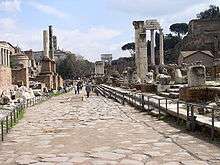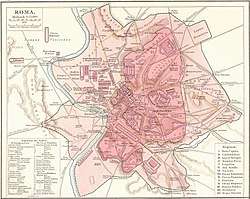Via Sacra
| Via Sacra | |
|---|---|
 Via Sacra passing through the Forum, with the Basilica Julia on the right | |
| Location | Rome, Italy |
| Related |
List of ancient monuments in Rome |
 | |
The Via Sacra (Latin: Via Sacra) (Sacred Road) was the main street of ancient Rome, leading from the top of the Capitoline Hill, through some of the most important religious sites of the Forum (where it is the widest street), to the Colosseum.
The road was part of the traditional route of the Roman Triumph that began on the outskirts of the city and proceeded through the Roman Forum. In the 5th century BC, the road was supported by a super-structure to protect it from the rain. Later it was paved and during the reign of Nero it was lined with colonnades.
The road provided the setting for many deeds and misdeeds of Rome's history, the solemn religious festivals, the magnificent triumphs of victorious generals, and the daily throng assembling in the Basilicas to chat, throw dice, engage in business, or secure justice. Many prostitutes lined the street as well, looking for potential customers.
Course
While the western stretch of the Via Sacra which runs through the Forum follows the original ancient route of the road, the eastern stretch between the end of the forum and the Colosseum, which passes underneath the Arch of Titus, is a redirection of the road built after the Great Fire of Rome in AD 64.[1] In the Republic and Early Empire, the route forked to the north near the House of the Vestals and passed through a saddle in the Velian Hill, now occupied largely by the Basilica of Maxentius and the modern Via dei Fori Imperiali. As part of his rebuilding program following the fire, Nero essentially straightened the road by redirecting it between the Velian and Palatine Hills, creating grand colonnades on either side for shop stalls and commerce.[2]
Sources
- Filippo Coarelli (2014). Rome and Environs. University of California Press. p. 81-82.
- L. Richardson, jr. A New Topographical Dictionary of Ancient Rome: Sacra Via.
References
| Wikimedia Commons has media related to Via Sacra (Rome). |